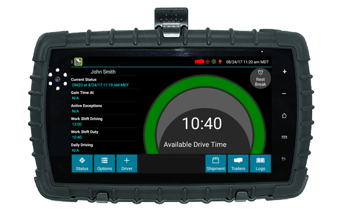December 18 is here at last. This is the day by which trucking companies must comply with the U.S. Government’s electronic logs mandate. For carriers, the mandate will bring stricter control over drivers’ hours of service (HOS). For shippers, it probably will bring higher freight costs.
The regulation, established by the Federal Motor Carrier Administration (FMSCA), says that trucking companies must install electronic logging devices (ELDs) on their trucks to record drivers’ HOS. The ELDs replace the paper logs that drivers have long used to show they are complying with federal HOS rules.
 The FMSCA published the ELD mandate in December 2015 but gave trucking companies three years to comply. As of today, nearly all commercial carriers must have these devices on board. Many carriers, especially the big ones, installed those devices quite some time ago. Others have been scrambling to meet the deadline. A survey by the company CarrierLists found that, as of December 11, three-quarters of smaller fleets had installed ELDs on their trucks.
The FMSCA published the ELD mandate in December 2015 but gave trucking companies three years to comply. As of today, nearly all commercial carriers must have these devices on board. Many carriers, especially the big ones, installed those devices quite some time ago. Others have been scrambling to meet the deadline. A survey by the company CarrierLists found that, as of December 11, three-quarters of smaller fleets had installed ELDs on their trucks.
The new regulation could reduce for-hire trucking capacity by 7 percent and increase spot rates by 5 to 15 percent, said Kenny Vieth, president of market research company ACT Research, in an interview last August with the trucking publication Transport Topics. Other experts make similar predictions.
Why will the electronic logs mandate eat into already-tight capacity and push up van and bulk shipping rates? There are a couple of reasons:
- Trucks will spend less time on the road. Drivers who used to fudge their written logs won’t be able to cheat anymore. That’s a good thing, of course: it makes the road safer. But drivers who have always played by the rules might also cut back on their time and miles, just to be safe. ELDs don’t leave any room for error. Good drivers will bend over backwards not to exceed their legal HOS by even ten minutes. All that precaution adds up to less trucking capacity, which translates into higher rates.
- The driver shortage could get worse. Some drivers just don’t want to put up with increased regulation and “Big Brother” in the cab. If enough of them leave the industry, that will also squeeze capacity and drive up rates for both dry van and bulk freight shipments. Carriers might also have to start paying drivers more to attract and retain them; that could drive up rates as well.
- Detention charges will increase. A driver sitting in your facility, waiting for you to unload, is on the clock just as though he were sitting behind the wheel. But he isn’t being productive. As ELDs bring stricter tracking of drivers’ hours, carriers are likely to impose higher detention charges, on top of per-mile costs.
How Can Shippers Save Money?
ELDs are here to stay, at least for now. But there are a few things you can do to keep the new mandate from putting a dent in your profits:
- Increase buffer inventory, so you don’t require high-priced emergency shipments when capacity gets tight.
- Look for ways to consolidate smaller shipments into larger ones—even combining LTL shipments into truckloads—so you’ll need fewer trucks.
- Make sure your drivers can get in and out of your facility promptly. You’ll avoid detention charges, and you might become a customer of choice for certain carriers. That will help to ensure that you can get a truck when you need one, at a reasonable rate.
As capacity tightens, remember that sourcing reliable capacity has been our thing at Bulk Connection since 1987.



